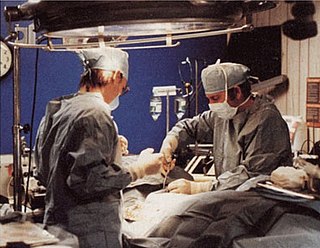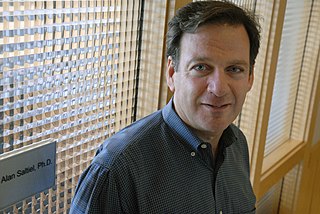
Cryonics is the low-temperature freezing and storage of human remains, with the speculative hope that resurrection may be possible in the future. Cryonics is regarded with skepticism within the mainstream scientific community. It is generally viewed as a pseudoscience, and its practice has been characterized as quackery.

Hibernation is a state of minimal activity and metabolic depression undergone by some animal species. Hibernation is a seasonal heterothermy characterized by low body-temperature, slow breathing and heart-rate, and low metabolic rate. It most commonly occurs during winter months.

Aestivation is a state of animal dormancy, similar to hibernation, although taking place in the summer rather than the winter. Aestivation is characterized by inactivity and a lowered metabolic rate, that is entered in response to high temperatures and arid conditions. It takes place during times of heat and dryness, which are often the summer months.
Cryobiology is the branch of biology that studies the effects of low temperatures on living things within Earth's cryosphere or in science. The word cryobiology is derived from the Greek words κρῧος [kryos], "cold", βίος [bios], "life", and λόγος [logos], "word". In practice, cryobiology is the study of biological material or systems at temperatures below normal. Materials or systems studied may include proteins, cells, tissues, organs, or whole organisms. Temperatures may range from moderately hypothermic conditions to cryogenic temperatures.

Dormancy is a period in an organism's life cycle when growth, development, and physical activity are temporarily stopped. This minimizes metabolic activity and therefore helps an organism to conserve energy. Dormancy tends to be closely associated with environmental conditions. Organisms can synchronize entry to a dormant phase with their environment through predictive or consequential means. Predictive dormancy occurs when an organism enters a dormant phase before the onset of adverse conditions. For example, photoperiod and decreasing temperature are used by many plants to predict the onset of winter. Consequential dormancy occurs when organisms enter a dormant phase after adverse conditions have arisen. This is commonly found in areas with an unpredictable climate. While very sudden changes in conditions may lead to a high mortality rate among animals relying on consequential dormancy, its use can be advantageous, as organisms remain active longer and are therefore able to make greater use of available resources.

The enzyme fructose bisphosphatase (EC 3.1.3.11; systematic name D-fructose-1,6-bisphosphate 1-phosphohydrolase) catalyses the conversion of fructose-1,6-bisphosphate to fructose 6-phosphate in gluconeogenesis and the Calvin cycle, which are both anabolic pathways:

Cryptobiosis or anabiosis is a metabolic state in extremophilic organisms in response to adverse environmental conditions such as desiccation, freezing, and oxygen deficiency. In the cryptobiotic state, all measurable metabolic processes stop, preventing reproduction, development, and repair. When environmental conditions return to being hospitable, the organism will return to its metabolic state of life as it was prior to cryptobiosis.

Lithobates sylvaticus or Rana sylvatica, commonly known as the wood frog, is a frog species that has a broad distribution over North America, extending from the boreal forest of the north to the southern Appalachians, with several notable disjunct populations including lowland eastern North Carolina. The wood frog has garnered attention from biologists because of its freeze tolerance, relatively great degree of terrestrialism, interesting habitat associations, and relatively long-range movements.
Peter William Hochachka, was a Canadian professor and zoologist at the University of British Columbia (UBC). He is known for his foundational work in creating the new field of adaptational biochemistry, connecting metabolic biochemistry with comparative physiology.
The Kolling Institute is located in the grounds of the Royal North Shore Hospital in St Leonards, Sydney Australia. The institute, founded in 1920, is the oldest medical research institute in New South Wales.

Insect winter ecology describes the overwinter survival strategies of insects, which are in many respects more similar to those of plants than to many other animals, such as mammals and birds. Unlike those animals, which can generate their own heat internally (endothermic), insects must rely on external sources to provide their heat (ectothermic). Thus, insects persisting in winter weather must tolerate freezing or rely on other mechanisms to avoid freezing. Loss of enzymatic function and eventual freezing due to low temperatures daily threatens the livelihood of these organisms during winter. Not surprisingly, insects have evolved a number of strategies to deal with the rigors of winter temperatures in places where they would otherwise not survive.

A hibernaculum is a place in which an animal seeks refuge, such as a bear using a cave to overwinter. The word can be used to describe a variety of shelters used by many kinds of animals, including insects, toads, lizards, snakes, bats, rodents, and primates of various species.

Alan Robert Saltiel is an American endocrinologist and biochemist. He is Distinguished Professor of Medicine and Pharmacology, holds the Maryam Ahmadian Endowed Chair in Metabolic Health, the Director of the UCSD/UCLA Diabetes Research Center and Director of the Institute for Diabetes and Metabolic Health at the University of California, San Diego.

Cryopreservation or cryoconservation is a process where biological material - cells, tissues, or organs - are frozen to preserve the material for an extended period of time. At low temperatures any cell metabolism which might cause damage to the biological material in question is effectively stopped. Cryopreservation is an effective way to transport biological samples over long distances, store samples for prolonged periods of time, and create a bank of samples for users. Molecules, referred to as cryoprotective agents (CPAs), are added to reduce the osmotic shock and physical stresses cells undergo in the freezing process. Some cryoprotective agents used in research are inspired by plants and animals in nature that have unique cold tolerance to survive harsh winters, including: trees, wood frogs, and tardigrades.

The Max Planck Institute (MPI) for Biology of Ageing, founded in 2008, is one of over 80 independent, non-profit-making institutes set up under the umbrella of the Max Planck Society. The overall research aim is to obtain fundamental insights into the aging process and thus to pave the way towards healthier aging in humans. An international research team drawn from almost 30 nations is working to uncover underlying molecular, physiological and evolutionary mechanisms.
Freezing tolerance describes the ability of plants to withstand subzero temperatures through the formation of ice crystals in the xylem and intercellular space, or apoplast, of their cells. Freezing tolerance is enhanced as a gradual adaptation to low temperature through a process known as cold acclimation, which initiates the transition to prepare for subzero temperatures through alterations in rate of metabolism, hormone levels and sugars. Freezing tolerance is rapidly enhanced during the first days of the cold acclimation process when temperature drops. Depending on the plant species, maximum freezing tolerance can be reached after only two weeks of exposure to low temperatures. The ability to control intercellular ice formation during freezing is critical to the survival of freeze-tolerant plants. If intracellular ice forms, it could be lethal to the plant when adhesion between cellular membranes and walls occur. The process of freezing tolerance through cold acclimation is a two-stage mechanism:
Kyle K. Biggar is a Canadian biochemist and molecular biologist. He has been a professor of biochemistry, chemistry, and biology at Carleton University in Ottawa, Canada since 2017. Biggar was the 2016 recipient of the John Charles Polanyi Prize for his outstanding work in early career research.
Carla Beth Green is an American neurobiologist and chronobiologist. She is a professor in the Department of Neuroscience and a Distinguished Scholar in Neuroscience at the University of Texas Southwestern Medical Center. She is the former president of the Society for Research on Biological Rhythms (SRBR), as well as a satellite member of the International Institute for Integrative Sleep Medicine at the University of Tsukuba in Japan.

Jean Elise Schaffer is an American physician-scientist. She is a Senior Investigator at the Joslin Diabetes Center, where she also serves as Associate Research Director, and she is Professor of Medicine at Harvard Medical School. Her work focuses on fundamental mechanisms of metabolic stress responses and the pathophysiology of diabetes complications.

Antonio Vidal-Puig is a Spanish medical doctor and scientist who works as a Professor of Molecular Nutrition and Metabolism at the University of Cambridge (UK), best known for advancing the concept that pharmacological targeting of brown fat may serve to treat overweight and obesity in affected individuals, as well as for introducing the concept of adipose tissue "expandability" as an important factor in the pathogenesis of insulin resistance in the context of positive energy balance. His published work focuses on areas such as adipose tissue metabolism and lipotoxicity, regulation of insulin secretion, and the pathophysiology of metabolic syndrome, obesity, and type 2 diabetes.













